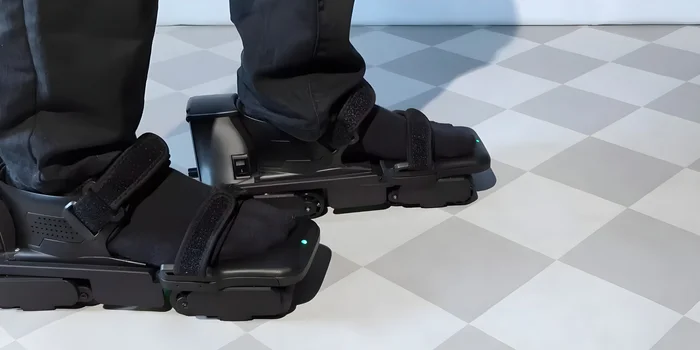
You'll be treading water: shoes with treadmills for VR games

For many people, walking is the preferred mode of movement in VR games. But this is precisely what is problematic. A British company wants to bring treadmill shoes onto the market.
Virtual reality is a fascinating experience: you feel completely transported to another environment. If only there wasn't the matter of movement. The best immersion would be moving on your own two feet. Because you are blind while playing in the real world and your space is usually limited, you can't normally walk around safely.
A British start-up is launching a new product on the market that is designed to give you more freedom: The Freeaim shoes use motorised rollers on the soles that help you walk on the spot. The principle of «walking on the spot» is nothing new for VR. Treadmills enable the same effect in a different way: They work like treadmills in the gym. However, such treadmills are very expensive and take up a lot of space. This usually makes them unsuitable for normal households.
With the Freeaim shoes, the developers want to offer a simple and space-saving alternative. The treadmills are housed in the soles of the shoes, so to speak. According to the developers, you can use them to jog slowly «» . The shoes are fully compatible with SteamVR and a few games from the Meta ecosystem.
The project is being crowd-funded via Kickstarter. The campaign has been successful: the campaign target of around 172,000 euros was far exceeded with around 283,000 euros raised.
Two variants for different degrees of freedom
The VR pedals, which are available in a simple and an advanced version, are reminiscent of retro roller skates: you attach them to your feet with Velcro straps. According to the development team, the movement feels like real walking, not like gliding or skating. The batteries in the shoe should last for around two hours of walking and are replaceable. Charging therefore takes around 15 minutes.
On the Kickstarter page, the VR shoes are described as a «full-body movement system that combines robotics, AI/machine learning, wearables and advanced sensor technology». Sensors detect your walking movements and adjust the speed of the motorised rollers so that you walk on the spot.
The «Advanced» version goes even further: it offers lateral position correction. The rollers can be swivelled and the shoes push you back to the starting position without you noticing. This should make it possible to use the Freeaim shoes on a normal floor without any further restrictions. The developers recommend an open area with a diameter of 1.5 metres and a guardian system - a virtual display of boundaries so that you don't run into a shelf if the worst comes to the worst.
The «Light» variant has no lateral position correction, so you move sideways unintentionally. A base plate is therefore required for this version. A frame is attached to this, which holds you in place with a hip belt, as with VR treadmills. Freeaim offers two different frames, one of which allows more arm room at the bottom. Both frames can be folded up quickly and stored together with the base plate to save space.
Real walking in VR has its price
Good VR treadmills often start at €2000 and upwards. However, the freeaim treadmills are not cheap either. The light version currently costs the equivalent of 989 euros or 914 francs in British pounds, while the advanced model costs 1269 euros or 1184 francs. You can pre-order them on the Kickstarter page.
According to Kickstarter, the design for series production has been finalised and the supply chain for the most important components is in place. The details for production are still being finalised at the moment. Delivery of the shoes is set to begin in 2026. After the launch, the price of the VR shoes is set to rise.
The standard for VR movement has not yet been set. Other companies are experimenting with rollers attached to plates, very smooth surfaces for shoes with low frictional resistance or swivel chairs with support for foot movements. Numerous DIY projects also demonstrate the creativity of private individuals, for example here.


Feels just as comfortable in front of a gaming PC as she does in a hammock in the garden. Likes the Roman Empire, container ships and science fiction books. Focuses mostly on unearthing news stories about IT and smart products.
From the latest iPhone to the return of 80s fashion. The editorial team will help you make sense of it all.
Show all